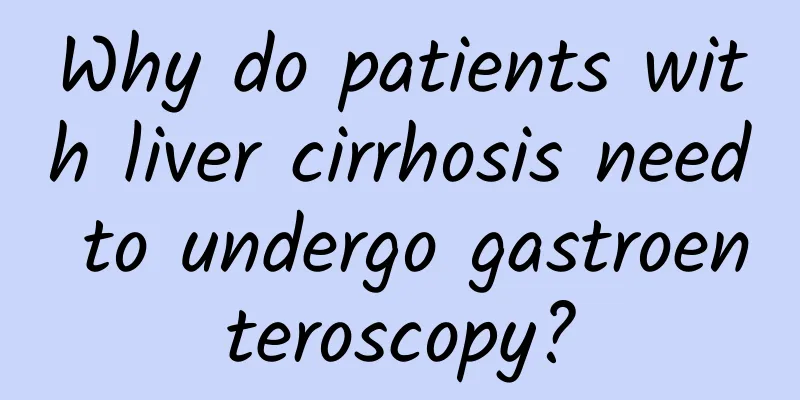Why do patients with liver cirrhosis need to undergo gastroenteroscopy?

|
Cirrhosis is a common chronic liver disease. As the disease progresses, it may affect the normal function of the gastrointestinal system. Therefore, it is necessary for patients with cirrhosis to undergo gastrointestinal endoscopy. This article will introduce in detail the relationship between cirrhosis and gastrointestinal lesions, the application of gastrointestinal endoscopy in diagnosis and treatment, special considerations for patients with cirrhosis, precautions during the examination, the limitations of gastrointestinal endoscopy in the treatment of cirrhosis, and other related examination methods. 1. Liver cirrhosis and gastrointestinal diseases Patients with liver cirrhosis often have gastrointestinal mucosal congestion, edema, erosion, ulcers and other lesions. These lesions can cause symptoms such as abdominal distension, acid reflux, belching, nausea, vomiting, and in severe cases, may also lead to bleeding, perforation, pyloric obstruction, etc. Through gastroenteroscopy, the lesions of the gastrointestinal mucosa can be visually observed, providing an important basis for diagnosis and treatment. 2. Application of gastroenteroscopy in diagnosis and treatment Gastroenteroscopy is a very effective diagnostic and therapeutic method that can be used to observe gastrointestinal mucosal lesions, take tissue biopsies, and treat gastrointestinal lesions. In patients with cirrhosis, gastroenteroscopy can be used for the following: (1) Diagnosis: Through gastroenteroscopy, the morphology, color, texture, etc. of the gastrointestinal mucosa can be observed, and tissue biopsy can be performed to determine the nature and extent of the lesions. (2) Treatment: Gastroenteroscopes can be used to perform therapeutic procedures such as hemostasis, stent placement, and pyloric dilation, which have a good effect on symptoms such as gastrointestinal bleeding and pyloric obstruction caused by cirrhosis. 3. Special considerations for patients with cirrhosis When patients with cirrhosis undergo gastrointestinal endoscopy, the following special factors need to be considered: (1) Portal hypertension: Patients with liver cirrhosis often have portal hypertension, which may lead to esophageal varices, gastric varices and other problems. When performing gastrointestinal endoscopy, it is necessary to choose appropriate examination methods and techniques to avoid inducing complications such as bleeding. (2) Upper gastrointestinal bleeding: Patients with cirrhosis are prone to upper gastrointestinal bleeding, and gastrointestinal endoscopy may induce or aggravate bleeding. Therefore, before the examination, the patient's medical history should be carefully understood, the risk of bleeding should be assessed, and appropriate preparations for hemostasis should be made. 4. Things to note during the inspection When performing a gastrointestinal endoscopy, you should pay attention to the following: (1) Laryngeal anesthesia: Before undergoing gastrointestinal endoscopy, the patient needs to undergo laryngeal anesthesia to relieve discomfort. After anesthesia, the patient should lie flat with the head tilted back to keep the airway open. (2) Gastrointestinal decompression: Before undergoing a gastrointestinal endoscopy, you should stop eating and perform gastrointestinal decompression to relieve uncomfortable symptoms such as abdominal distension and acid reflux. During gastrointestinal decompression, you should pay attention to maintaining oral hygiene. (3) Monitoring of vital signs: During the examination, the patient's vital signs, such as blood pressure, heart rate, and blood oxygen saturation, need to be monitored to ensure patient safety. Summarize It is very necessary for patients with cirrhosis to undergo gastrointestinal endoscopy, which can observe gastrointestinal mucosal lesions, perform tissue biopsies, and treat gastrointestinal lesions. However, special considerations such as portal hypertension and upper gastrointestinal bleeding should be taken into account during the examination. It is recommended that patients with cirrhosis choose appropriate examination methods under the guidance of a doctor so as to detect and treat gastrointestinal lesions in a timely manner. |
<<: Can diabetes cause blindness? It's true!
>>: Popularize the early screening of cervical cancer
Recommend
Can stroke patients drink alcohol? The guide will tell you
Author: Wang Lei, deputy chief physician, Beijing...
[Fat Bear Popular Science] Pay attention! There are still so many friends asking about radiotherapy. I will sort it out again today. Don’t blame Fat Bear for not talking about it...
In May, Pang Xiong published an in-depth article ...
Postmenopausal uterine bleeding
When women reach a certain age, they stop having ...
10 kinds of food that nutritionists hardly eat, but you may be eating them every day!
There are many foods that nutritionists almost ne...
How is my skin after my period?
Many women call their menstrual period "mens...
Is it okay not to brush your teeth in the morning?
The first thing everyone does when they wake up i...
Fungal infection pictures
Mold is a type of bacteria, and its characteristi...
Girl with cold hands and feet
Girls are most likely to have cold hands and feet...
A small "quail egg" grew on the right eyelid. The 63-year-old man was diagnosed with cancer.
A tumor inexplicably grew on his right eyelid. Wi...
Tips for COVID-19 medication | Electrolyte drinks ≠ oral rehydration salts, scientific rehydration is crucial!
The human body contains a large amount of fluid, ...
It is necessary to have a physical examination if you are over 50 years old.
Many people say that the elderly, especially thos...
What are the causes of secondary dysmenorrhea?
The problem of dysmenorrhea troubles many female ...
What should I do if my menstrual cycle is too short?
Nowadays, many women are troubled by menstrual pr...
Is a sudden drop in body temperature a sign of ovulation?
During the ovulation period, women will experienc...









